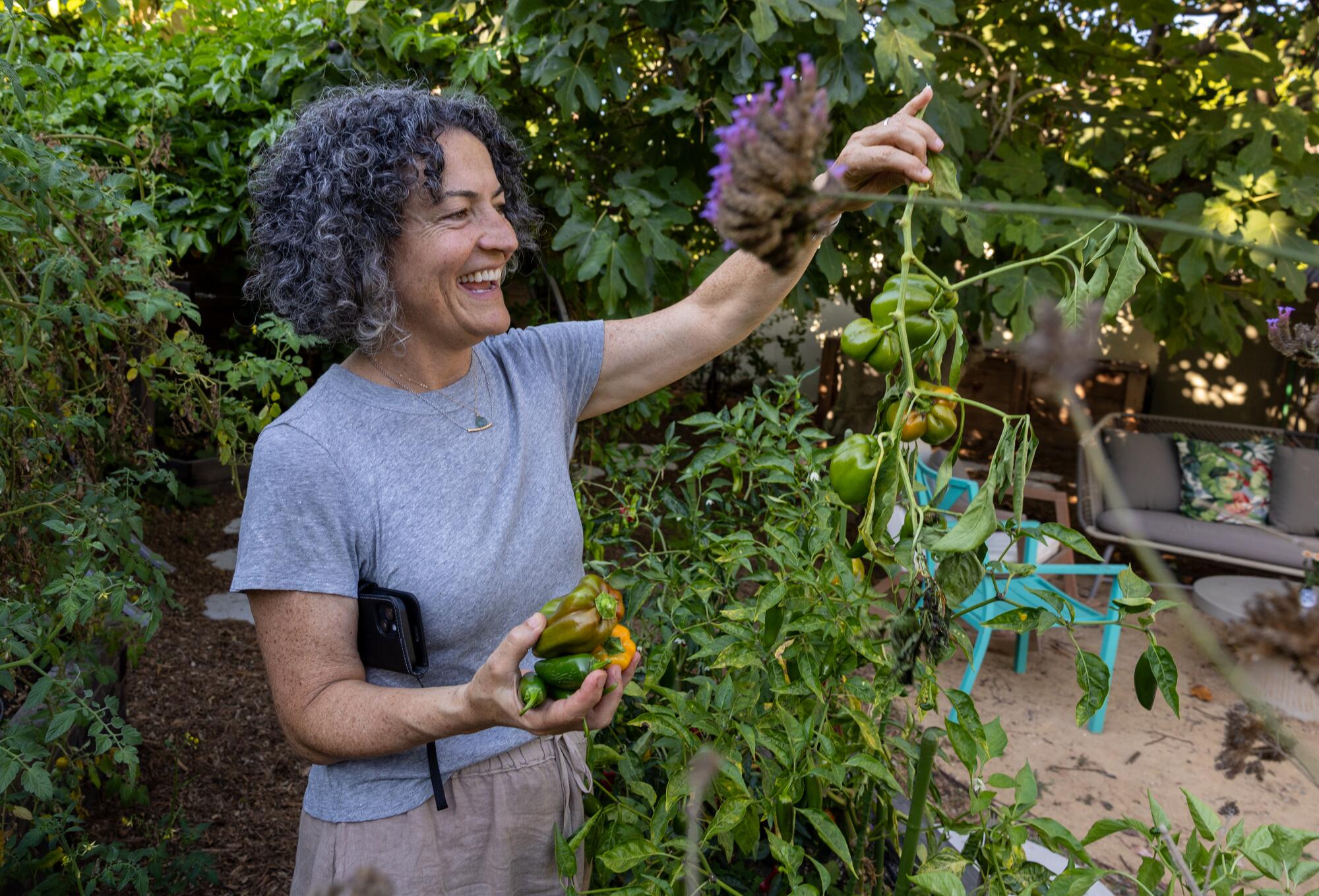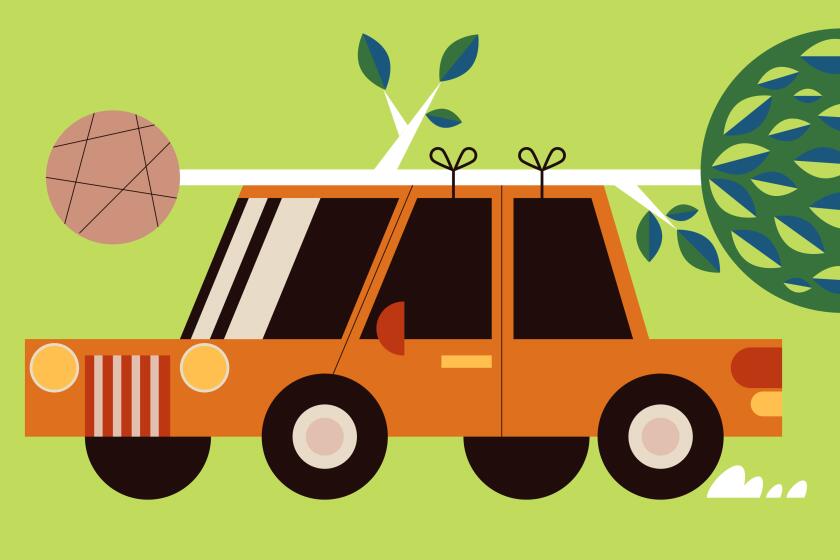
- Share via
? The problem: a lawn that monopolized the backyard’s sunny spots, leaving the food-growing areas shaded by towering fig and avocado trees.
? The answer: relandscaping the entire 5,000-square-foot yard to create a flourishing mini-farm and provide real-world lessons while the family sheltered in place during COVID.
Water-hungry lawns are symbols of Los Angeles’ past. In this series, we spotlight yards with alternative, low-water landscaping built for the future.
Like most families stuck at home during the pandemic, psychologist Angel Black and her husband, philosophy professor Tim Black, struggled with maintaining their careers while helping their children manage their learning.

Luckily, Angel had a dream/distraction up her sleeve — transforming the family’s lawn-heavy yard in Culver City into a “big food-producing area,” where the Blacks’ two children could wander and graze while she grew the produce she craved.
It all came together in an unexpected way to create a mini-farm garden retreat that also provided hands-on lessons in landscaping for their inquisitive 8-year-old son, Early, whose alternative school closed in the first weeks of the pandemic shutdown. Their daughter, Ruby, then 13, could go to school online, but that wasn’t an option for Early’s outdoor-based school.
“I had tried to grow things on my own in a tiny raised bed, but nothing worked,” Angel said. “I just couldn’t figure out how to get enough sun. So I Googled ‘transforming a backyard into a food-producing space.’ The Farmscape website popped up, and I thought, ‘OMG, this is who I need.’”
You’d think L.A.’s ‘perfect’ street tree would be a California native. So why does the city plant so many trees from somewhere else? Plus a list of plant events.
Angel met with Farmscape designer Catherine McLaughlin in January 2020, a few months before COVID-19 brought the world to a standstill. She understood immediately what needed to be done, McLaughlin said.
The tiny raised beds in the Blacks’ backyard produced lackluster harvests, if anything at all, because they were tucked under large fig and avocado trees, McLaughlin said. The backyard lawn took up most of the sun, and the front yard lawn, heavily shaded by the stately elm trees lining the block, was so compacted and sun-deprived “it was basically already dead.”
Often, the biggest problem with turf removal projects is getting everyone to agree to removing the lawn, McLaughlin said. “It’s very hard for the family — usually the husbands — to give up their lawn space. It’s ingrained in us — we have a big attachment to flat green monocultures. People like to see the expanse of their land, and they justify it with this vague idea like, ‘Someday, we’ll play football out there.’”

Her technique to make the transition easier? Encouraging reluctant lawn removers to use nearby parks, which in the case of the Black family is only a block away.
Luckily, Early, the biggest lawn user, was excited about revamping the yard, Angel said. Her husband and daughter loved the idea of growing food as long “as they didn’t have to do any actual gardening,” she said, laughing. And she was eager to learn as much as she could about planting and maintaining a garden.
Many municipalities and utilities around L.A. offer free trees for residents to plant in their yards or they will add trees to parkways. Here’s a list.
But ultimately it was the pandemic that provided the catalyst to relandscape their entire 5,000-square-foot yard. They spent about $50,000 to transform their front and back yards, but it also transformed their lives, Angel said, providing the family with garden retreats, lots of fresh veggies and hands-on lessons for Early.
The lessons were a surprise bonus, Angel said. When Farmscape brought in all its equipment to start removing the lawns, Early was enthralled.
“He was like, ‘Wait a minute, look at these cool machines they’re using to dig up my yard,’” Angel said. “He had no school at that point, and he and the foreman, Lowell Frank, really hit it off. Early would sit outside and watch them, and one day Lowell invited him to join them. After that, Early was out there at 8 a.m. every day for six weeks, and he got to do everything, even pushing the rototiller. He went to landscaping school for six weeks, and it was amazing.”

“[Frank] was so patient about teaching him,” Angel said. “To keep costs down, they said maybe we could help with some of the planting, so Early and I got very involved in the garden.” Frank has since moved to New Mexico, Angel said, but before he left, he made Early his own toolbox and filled it with garden tools. The two have stayed in touch by exchanging letters.
A Porter Ranch family lost their huge terraced yard to the 2019 Saddleridge fire, but it gave them a blank slate to create a fire-resistant native habitat.
The front yard was designed with Early in mind too, said McLaughlin. They built a berm to provide privacy for the small seating area by the front door and added mostly native plants such as California fescue, pitcher sage, sagebrush, yarrow, Catalina currant, seaside daisy and spring wildflowers as well as edibles such as miner’s lettuce and frilly chrysanthmum (a non-native edible green).
Farmscape was so busy in 2020 that the work didn’t begin until that fall. The backyard lawn was removed to make way for three deep raised beds made of stacked 4-by-4-inch redwood posts. The fig and avocado trees were pruned a bit to allow as much sun as possible into the garden; a round steel trellis was installed on a walkway to support a thriving passion fruit vine; a guava hedge was cut back to create room for a blackberry patch and fruit trees such as white nectarine and pomegranate; and thick mulch was laid around the walkways to deter weeds.


Now the backyard feels like a series of outdoor spaces, with the deck leading to the raised-bed garden leading to the restful seating area shaded by the mature — and very productive — fig and avocado trees. Further back is the three-tier composting system set up by Farmscape, which Angel says is the “secret sauce” to her garden’s success.
“That first summer, when we put compost on our garden, it was crazy,” she said. “I was like, ‘Ohhh, so this is how you get 9-foot-tall tomatoes.”
Finding enough sun to grow healthy crops was another matter. The garden beds are set at angles to the deck, based on the readings McLaughlin got from her Sun Seeker Tracker Surveyor app ($9.99), which lets people track the sun’s movement through their yard at different times of the year.
“We recommend this app to anyone trying to best locate their vegetable garden,” McLaughlin wrote in a text. “We think $9.99 is a good insurance policy against years of stunted veggies” because they aren’t getting enough sun. Warm-season vegetables such as tomatoes, peppers and cucumbers need at least six to eight hours of sunlight a day to thrive.
Farmscape usually maintains the raised bed gardens it creates, visiting the sites weekly to keep everything tidy, but Angel was so invested in doing the gardening herself that McLaughlin says her crews only come a couple of times a year now to do seasonal maintenance such as helping her “flip” the beds from a summer garden of tomatoes, peppers, chard, basil and cucumbers to a winter garden heavy with greens, broccoli and sugar snap peas.

“We are not vegetarians, but I am a very big vegetable eater, and I’d say every day something in our meals comes from the garden. We’re everyday-salad people so I always plant tons of lettuce in the winter, plus mustards and collards and kale,” Angel said.
“This garden has turned out way better than I ever imagined, and we get so much more food than I ever imagined; I love giving food away to family and friends, but I also do a lot of freezing. With tomatoes, did you know you can just freeze them whole and then when you’re ready to use them in a soup or stew, you can just run them under water and the skins fall right off?”
(Her technique, for others who have too many tomatoes, is to put whole tomatoes on a cookie sheet until they’re frozen solid, and then pop them into freezer bags for storage, until they’re needed for winter meals.)
Angel said she was “shocked” by the drop in their water bill, to about a third of what they were paying when they were watering their lawn. “I didn’t know how that was going to be possible, because we had many more plants to water, but switching to drip irrigation made such a difference from regular sprinklers.”
And Early? Now that he’s 12, his interest in gardening has given way to another passion: baseball. He’s a pitcher and catcher and there’s a small batting cage in the backyard where he can practice, between the garden beds and the deck.
His feelings about the garden and lawn have changed some, four years later. “It would be cool to have some grass here,” he said slowly, as his mother and McLaughlin held their breath, “but it’s way better like this.”
Why? He looked around the garden, considering. “Because we get a lot of food now, it looks better...,” he trailed off and shot an impish grin at the two women, “and I don’t have to mow it.”
More to Read
Sign up for The Wild
We’ll help you find the best places to hike, bike and run, as well as the perfect silent spots for meditation and yoga.
You may occasionally receive promotional content from the Los Angeles Times.















